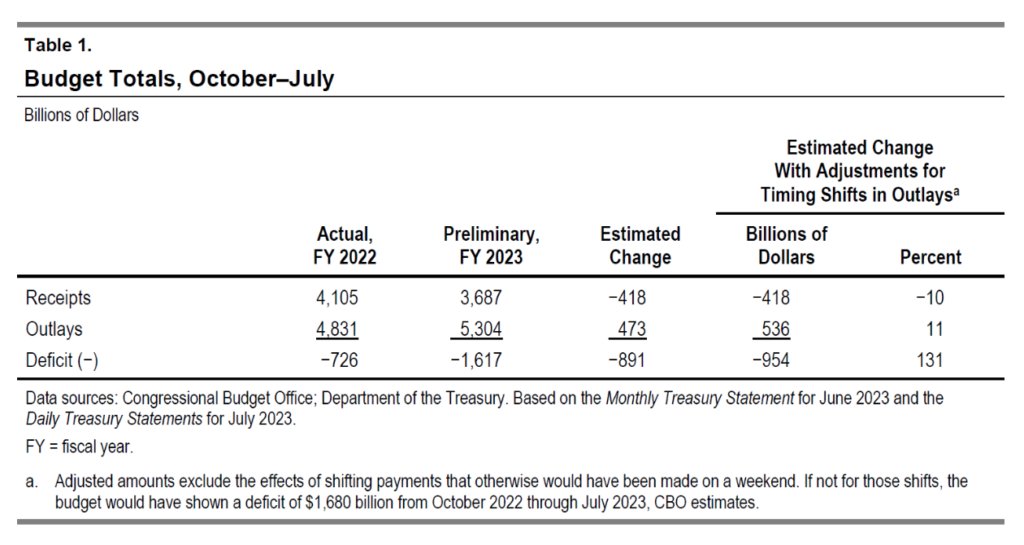CBO Report Shows Biden Administration Drowning Americans in a Sea of Red Ink
In his State of the Union message in February, President Biden bragged that his “administration cut the deficit by more than $1.7 trillion — the largest deficit reduction in American history.” That boast lasted barely six months.
Biden’s supposed “achievement” always amounted to less than meets the eye. His administration deserves about as much credit for not continuing the trillions of dollars in spending disguised as “Covid relief” — only because a few Democrats refused to continue the binge in perpetuity — as someone on a bender who stops drinking because he’s run out of booze.
But the Congressional Budget Office’s recent monthly budget review shows how much the nation’s financial situation has deteriorated just since February. Even more alarming, it hints at the larger fiscal problems yet to come.
Taxes Down…
A table at the front of the CBO report lays out the problem in stark detail: Over the first 10 months of the current fiscal year, the federal deficit has more than doubled compared to last year, rising from $726 billion to $1.7 trillion, after the effects of timing shifts are removed.

Even compared to CBO’s baseline estimates in May, which forecast a deficit of “only” $1.5 trillion this year, the budget situation declined by another $200 billion.
The causes of fiscal deterioration are myriad. Tax receipts have fallen by roughly 10 percent compared to last year, largely because individual income tax receipts declined 20 percent. The budget gnomes guessed that “one factor may be smaller collections of taxes on capital gains” due to recent gyrations in the stock market. For all the Democratic obsession with “taxing the rich,” this data point should provide an important reminder that doing so only works if “the rich” actually make money in the first place.
…And Spending Up
A bigger contributor to the deficit increase came in the form of increased spending, more than half a trillion dollars’ worth, if one controls for the effects of timing shifts. (These shifts occur when the end of a month, or fiscal year, occurs on a weekend.) Major mandatory spending programs rose by a collective $206 billion, a sum so large because payments in Medicare and Social Security increased according to inflation, which has skyrocketed to 40-year highs.
Spending on the Department of Education rose by $91 billion compared to last fiscal year. That change occurred because the administration booked charges related to two of its latest student “loan” giveaway proposals, regarding public service forgiveness and income-driven repayment. Even after the Supreme Court struck down its $20,000-per-borrower giveaway, this administration is still spending billions of taxpayer dollars it doesn’t have trying to buy students’ votes.
Debt Bomb Ahead
But the biggest increase in spending came in an ominous category: Debt service costs rose by $146 billion, or 34 percent, compared to this time last year. As interest rates rise due to the inflation Democrats’ spending sprees have caused, the cost of servicing our debt grows ever higher.
Even the $572 billion the federal government has paid in interest costs this fiscal year will likely prove lower than the sums Washington will pay going forward. At the beginning of the current fiscal year last Oct. 1, the Federal Reserve had set interest rates in a range of between 3-3.25 percent. Now, they are between 5.25-5.5 percent. As a result, when the federal government has to take on additional debt, and/or refinance its existing debt, it will have to pay much higher interest rates to do so.
The $572 billion paid in interest costs this fiscal year represents 15.5 percent of receipts, or nearly $1 in $6 the federal government has taken in over the last 10 months. And with those interest costs almost certain to grow, at a point in the not-too-distant future, we could face a scenario where borrowing merely begets more interest and more borrowing.
All of this fiscal doom and gloom comes at a time when the administration is trying to take credit for its economic “achievements.” Somehow, the president has yet to take credit for the fiscal elements of its agenda. But to borrow the White House’s favored political messaging, “Trillions of dollars in debt, and no way out — that’s Bidenomics.”
This post was originally published at The Federalist.